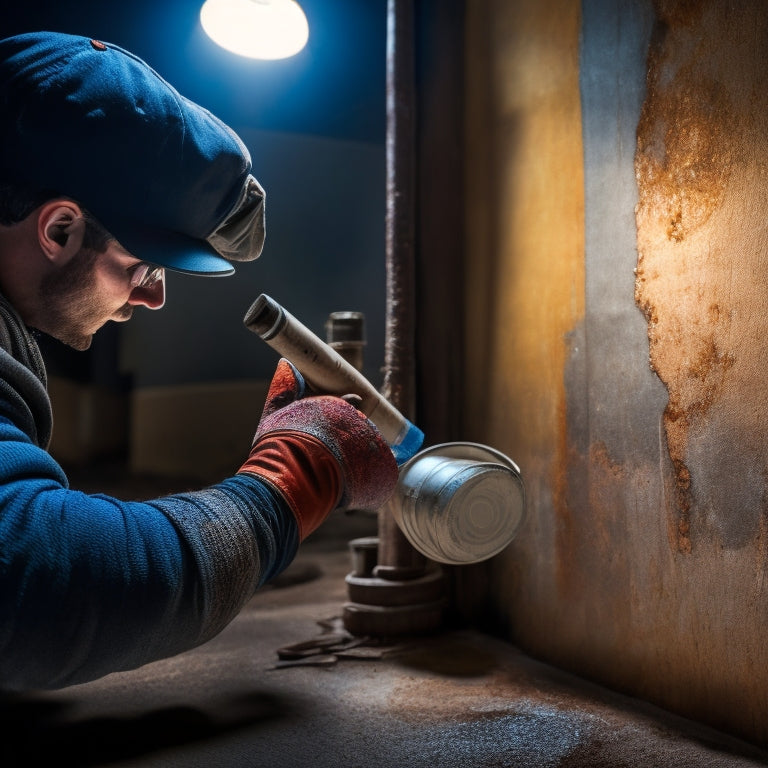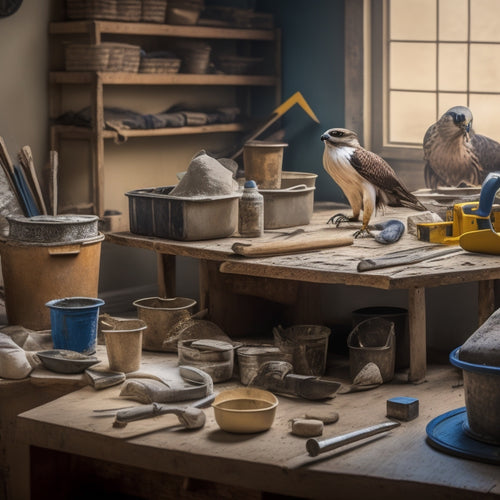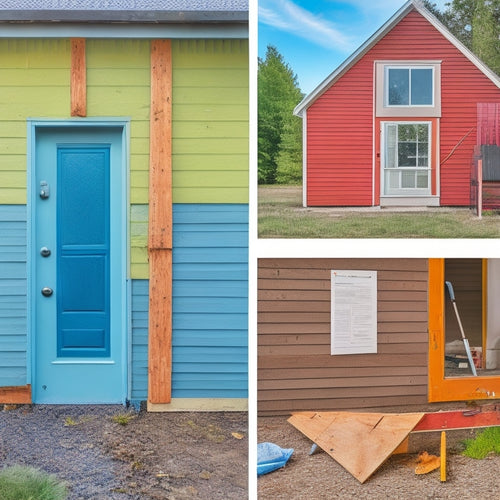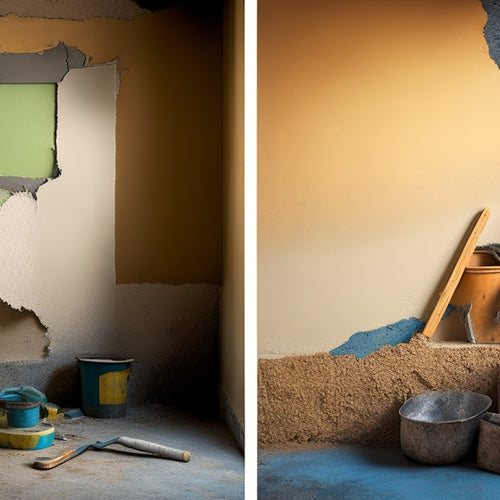
Inspecting Wall Materials for Home Renovation
Share
When inspecting wall materials for your home renovation, you'll want to start by evaluating the quality of the blocks, checking for signs of damage, defects, or moisture issues. Verify the materials' compliance with regional standards and certifications, and conduct tests for durability, compressive strength, and density. Assess the structural integrity of the walls, considering weight and stress factors, and identify any potential hazards or logistical challenges on-site. By doing so, you'll uncover critical information that'll inform your renovation plan and help you avoid costly rework down the line - and that's just the beginning of what you need to know.
Key Takeaways
• Inspect wall materials for structural integrity, checking for cracks, damaged corners, and weight consistency with manufacturer's specifications.
• Conduct durability testing for compressive strength, absorption, and density to ensure compliance with regional manufacturing standards.
• Perform visual inspections for damage signs, surface imperfections, and moisture assessment to identify underlying issues.
• Verify material quantities accurately, noting condition and quality, to create a realistic project timeline and budget.
• Evaluate site readiness, identifying potential hazards, logistical challenges, and preparation tasks to ensure a smooth renovation process.
Block Material Quality Control
When selecting block materials for your home renovation, inspecting their quality is essential to guarantee structural integrity and prevent costly rework. You'll want to make certain the blocks meet the required manufacturing standards, which vary depending on the region and type of block. Look for certifications from reputable organizations, such as the International Association of Certified Home Inspectors or the National Ready Mixed Concrete Association.
Conducting block durability testing is also important. This involves evaluating the block's compressive strength, absorption, and density. You can perform these tests in-house or hire a third-party testing service.
Additionally, inspect the block's surface for any imperfections, such as cracks or damaged corners. Check the block's weight, as it should be consistent with the manufacturer's specifications.
Damage and Defect Inspection
You should visually inspect the blocks for signs of damage or defects, checking for cracks, chips, or broken edges that could compromise their structural integrity. This inspection is essential to identify potential issues that may affect the overall performance of the wall.
As you examine the blocks, pay attention to surface imperfections, such as scratches, discoloration, or unevenness, which can indicate underlying problems.
Next, perform a moisture assessment to detect any signs of water damage or excessive moisture absorption. Check for stains, discoloration, or efflorescence on the block surfaces, which can indicate water seepage or high humidity levels.
You should also inspect the blocks for signs of wear, such as erosion or erosion patterns, which can indicate exposure to harsh environmental conditions.
Remember to document your findings and take note of any damage or defects you discover. This information will help you determine the best course of action for repair or replacement, guaranteeing that your renovated walls are safe, durable, and meet your desired standards.
Structural Integrity Assessment
Every block's structural integrity should be evaluated to confirm it can withstand the weight and stress of the surrounding structure, as well as external factors like weather and environmental conditions.
You'll want to assess the load-bearing capacity of each component, from the foundation to the roof, to verify they can handle the weight of the building and its occupants. A load-bearing analysis will help you identify any weak points that need reinforcement or replacement.
Next, you'll need to perform a moisture assessment to detect any signs of water damage or infiltration. Check for signs of dampness, warping, or discoloration on walls, floors, and ceilings.
Use specialized equipment, such as moisture meters or thermal imaging cameras, to detect hidden moisture issues. This is essential, as excessive moisture can compromise the structural integrity of your walls and create ideal conditions for mold growth.
Material Quantity Verification
Accurate material quantity verification involves counting and measuring existing materials to determine what can be reused, repurposed, or removed, ensuring a precise calculation of new materials needed for the renovation.
You'll need to conduct a thorough inventory of the existing materials, taking note of their condition, quality, and quantity. This will help you identify what can be salvaged and what needs to be replaced.
Quantity estimation techniques, such as measuring wall areas and calculating material requirements, will also come into play. By accurately estimating the material quantities needed, you can develop effective material sourcing strategies, reducing waste and saving costs.
Be sure to account for any potential material losses or damage during the renovation process. A precise material quantity verification will enable you to create a realistic project timeline and budget, ensuring a successful home renovation.
Site Readiness Evaluation
Before commencing the renovation, a thorough site readiness evaluation is essential to identify potential hazards, obstacles, and logistical challenges that may impact the project's timeline, budget, or quality.
You'll need to assess site access, guaranteeing that it's safe and convenient for workers, equipment, and materials. Evaluate the condition of the existing structure, including any necessary permits, utilities, and environmental concerns.
Create a preparation checklist to guarantee all necessary tasks are completed before construction begins. This should include clearing the site of debris, removing hazardous materials, and protecting adjacent properties.
You'll also need to establish a waste management plan, set up temporary facilities, and implement safety protocols. Identify any potential issues with neighboring properties, such as shared walls or common areas, and develop a plan to mitigate any potential disruptions.
Frequently Asked Questions
Can I Inspect Wall Materials Without Professional Help or Training?
You can inspect wall materials on your own, but it's crucial to know what to look for.
Start by identifying the wall material types, such as drywall, plaster, or wood.
Then, follow DIY inspection tips, like checking for cracks, water damage, and signs of pest infestation.
Be thorough, but don't attempt to inspect areas that require specialized training, like asbestos or lead-based paint.
Know your limits and consider hiring a pro if you're unsure.
How Long Does a Typical Wall Material Inspection Process Take?
Time is ticking, and you're wondering how long the clock will tick for a typical wall material inspection process.
The inspection duration largely depends on the scope of the project and the material assessment required.
On average, a thorough inspection can take anywhere from a few hours to several days, depending on the complexity of the material assessment and the number of samples to be analyzed.
Are There Any Specific Tools Required for Inspecting Wall Materials?
When you're inspecting materials, you'll need specific tools to get accurate results.
You'll likely need a moisture meter to detect any hidden water damage or leaks.
Additionally, thermal imaging technology can help you identify temperature anomalies behind walls, indicating potential issues.
These specialized tools will help you pinpoint problems that might be invisible to the naked eye, ensuring you get a thorough assessment.
What Is the Ideal Time to Inspect Wall Materials During Renovation?
When planning your project, you'll want to identify the ideal time to inspect wall materials.
Ideally, you should do this early in the renovation timeline, before any demolition or construction begins.
This allows you to assess the wall condition, identify potential issues, and adjust your plans accordingly.
Can I Reuse Old Wall Materials After Inspecting and Repairing Them?
You've invested time and effort into inspecting and repairing old wall materials, but can you really reuse them? Surprisingly, yes, you can.
With the right restoration techniques, old wall materials can regain their durability. Assess the material's condition, and if it's still structurally sound, you can refinish or repurpose it.
This eco-friendly approach reduces waste and saves you money. It's a win-win, but only if you've done your due diligence in inspecting and repairing them properly.
Conclusion
As you stand back to admire your renovation's foundation, remember that a strong wall is like a fortress, shielding your dreams from the outside world.
But, just as a fortress is only as strong as its weakest brick, your walls are only as reliable as their materials.
By inspecting wall materials, you've laid the groundwork for a sturdy structure that will weather life's storms.
Now, with a solid foundation in place, you're ready to build a home that will stand the test of time.
Related Posts
-

Affordable Plastering Tools for Home Renovation Success
You're taking the first step towards a successful home renovation by investing in the right plastering tools. Start w...
-

Why Exterior Wall Renovation Requires a Plan
You're about to commence a complex and potentially costly project when you decide to renovate your exterior walls, an...
-

Top 3 Tools to Buy for Stucco Renovation
You'll need the right tools to guarantee a successful stucco renovation, and it all starts with three essential items...


